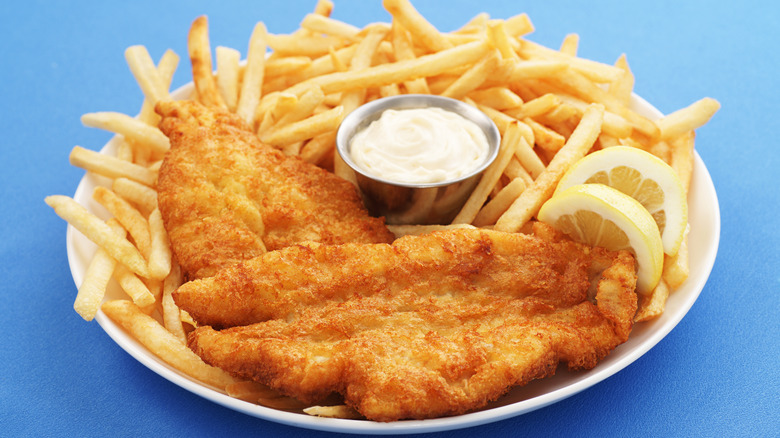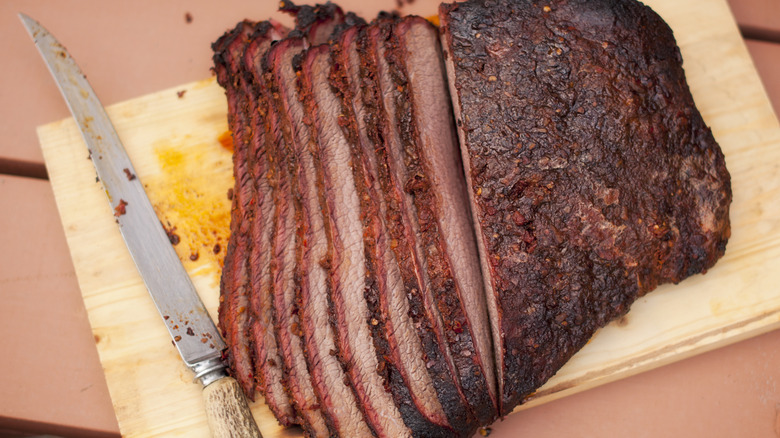Way More Foods Are Jewish In Origin Than You Think
When you think of Jewish food, you might think of things like kugel, rugelach, sufganiyot, hamentashen, latkes, and matzah. These are obviously ethnic foods that either don't have much market penetration (the first four items) or do, but are mostly associated with Jewish religious observances (latkes and matzah). At most, you might think of things like whitefish or chopped liver — or maybe a Reuben or pastrami sandwich.
The thing is, a whole lot more foods are Jewish in origin than people may realize — far out of proportion to the size of the Jewish community in America (roughly 2.4% of the general population). Many people, for instance, don't know that bagels are a wholly Jewish invention, originating in Poland sometime during the 15th or 16th centuries. Bagels have become so ubiquitous that many Gentiles have forgotten where they came from, but they're still far more obviously Jewish than other foods that even many Jews don't realize we created.
You probably wouldn't believe some of the foods that originated with Jews
The list of foods here is long, and it includes some you'd never guess. We're not talking about Reuben sandwiches here but dishes like fried green tomatoes, long associated with the American South but actually an invention of northern Jews in the late 19th century. Foie gras, one of the national dishes of France, was originally created by accident by Middle Eastern Jews looking to produce more schmaltz (poultry fat). And were it not for Jews, American BBQ culture would look wholly different. Brisket is another food for which you can thank the chosen people. What started as a traditional Jewish holiday dish eventually became the state dish of Texas. Yeehaw, l'chaim!
The most surprising entry, though, might be fish and chips. We know beyond doubt that fish and chips were a Jewish creation (numerous early historical sources, including Thomas Jefferson, refer to them as "fish fried in the Jewish fashion"). They arrived in England during the mid-17th century and the brief reign of Lord Protector Oliver Cromwell, who lifted the formal ban on Jewish immigration dating from 1290, openly inviting Sephardic Jews from Amsterdam to emigrate to Great Britain. The dish took off in the 19th century, eventually becoming the national dish of the empire on which the sun never set (until it did).
Many foods Jews did not invent were spread by Jewish immigrants
Other foods that weren't directly created by the Jewish people were spread by Jewish immigrants. Take shakshouka, a food you might've seen on cooking shows in the last half-decade. A mixture of eggs poached in tomatoes, olive oil, peppers, onion, garlic, and spices, shakshouka is a Maghrebi Arab dish from North Africa or the Middle East. We're not sure of its origins. There are competing claims to its creation from Morocco to every other North African country to Turkey and Yemen. What we know for sure is that when North African Sephardic Jewish immigrants moved to Israel in the 1950s and '60s, they took the dish with them. It took a few decades, but ultimately, shakshouka jumped to American menus in the 1990s.
Another example is macaroons. No, not macarons, the almond-flour-based French confection filled with jelly or cream. Macaroons are small coconut cookies with a light, fluffy texture. Macaroons originated with Italian monks in the 8th or 9th century, but they didn't rise to prominence until they became extremely popular in the Italian Jewish community centuries later. This was in large part due to the fact macaroons do not contain a leavening agent, meaning Jews can eat them during Passover. From there, Italian Jews spread the gospel of the macaroon to other European Jews, who eventually brought the baked good to America.


